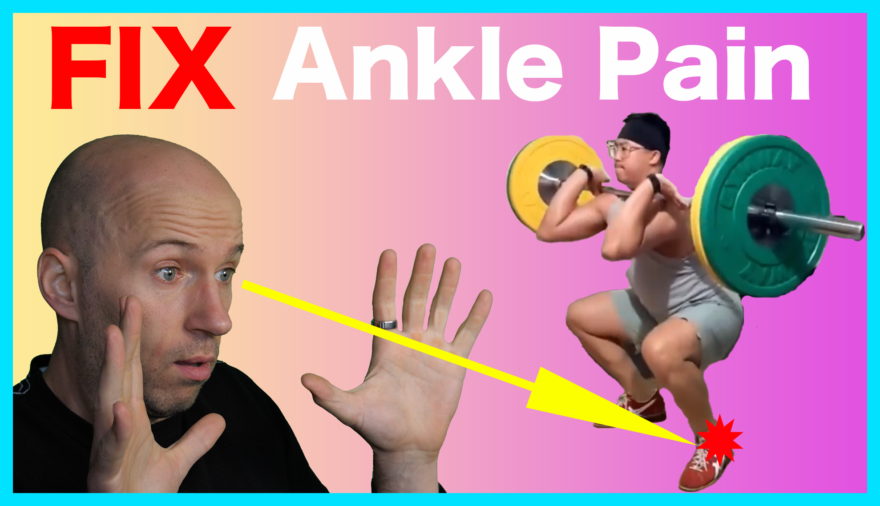Table of Contents
Does triple extension hurt your ankle? Check out this case to learn about the fix
Have you ever had inner ankle pain when you go up on your toes or jump and are unsure what to do about it?
Oftentimes, this occurs when there is an inability to create ankle plantarflexion (going up on your toes), so more stress is put on the inner portion of the ankle.
But what if I told tyou those ankle restrictions can be related to the pelvis, and if you don’t address that, you’ll be missing on some key things.
That’s what we go through in today’s case study.
Check out the video and case summary below to see what we did!
Case overview
This is the third follow-up with our boy Kevin. (Watch part 1 here and part 2 here).
In the one month since I last saw him, he made A TON of progress. His pain decreased from a 5/10 to a 2/10 and has gotten back to Olympic weightlifting for 3 weeks without any symptom increase.
He did experience a symptom flare-up after playing some pickleball but overall has seen some nice progress.
Objective findings
Here were Kevin’s initial findings from this session. His measures from 1 month ago are in parentheses. If they weren’t in parentheses, it’s because they didn’t change from the previous session
| Test | Left | Right |
| Infrasternal angle | wide | |
| Shoulder flexion | 110 (85) | 110 (80) |
| Shoulder external rotation | 90 | 90 |
| Shoulder Internal rotation | 90 | 90 |
| Hip flexion | 100 (110) | 100 (110) |
| Hip external rotation | 60 | 60 (45) |
| Hip internal rotation | 40 | 45 |
| Straight leg raise | 80 (75) | 80 (75) |
| Hip extension/adduction | 25% add (0) | 25% |
| Lower cervical rotation | + | + |
| Squat | NO pain | |
| Knee extension | -5 (-3) | -7 |
| Ankle dorsiflexion | 15 (10) | 10 (20) |
| Ankle plantarflexion | 35 (30) | 45 (40) |
| Ankle Inversion | 50 | 45 |
| Ankle Eversion | 5 | 3 |
| Big toe extension (ankle PF) | 15 | 15 |
| Big toe extension (ankle DF) | 15 | 15 |
| Bilateral heel raise | painful | |
| Unilateral heel raise | not tested |
You can see that Kevin continue to make rock solid improvements and his hips are pretty dang solid.
You might’ve noticed a few things:
- hip flexion is “worse”
- Asymmetry in ankle dorsiflexion (worse right) and plantarflexion (worse left)
I do not see the worsening hip flexion as a bad thing. Given his previous external rotation deficit, chances are that he was posteriorly orienting his lumbar spine during hip flexion previously. Given that we have hip external rotation now, this is likely a “true” measure of hip flexion.
But the issue here is that we have fairly clean hip measures. Why does his ankle hurt?
Now we have to look how the right oblique axis in the pelvis manifests distally.
As we discussed in the last case, the right oblique orientation presents with the following stuff:
| TEST | LEFT | RIGHT |
| Straight leg raise | more | less |
| Hip external rotation | more | less |
| Hip internal rotation | less | more |
Although the measures present above, there is actually posterior compression/muscle activity that causes the turn to the right. This would indicate an internal rotation action creating that (posterior tension = decreased external rotation). The reason why your rotational measures don’t match this is because of an orientation issues. The direction the pelvis orients gives the appearance described above, which doesn’t accurately reflect where you have to create space.
How does this relate to the ankle?
GLAD YOU ASKED, I AM.
Ankle movements correpond with the following rotations in the lower body:
- ankle dorsiflexion = internal rotation
- Ankle plantarflexion = external rotation
So if I have a loss of these measures, then we can say that there is a loss of left external rotation and right internal rotation, which would create a pelvic turn right. Because we have “cleaned” this up proximally, we now are seeing this strategy manifest more distally.
So intervention-wise, the song remains the same, we just may have to emphasize more of a foot strategy.
Intervention selection
Given the findings above, the big focus for Kevin will be as follows:
- Progress the left pelvis turn to counteract right oblique axis
- Progress to more dynamic/explosive activities to bridge the gap to the terminal task (triple extension)
Here’s how we did it.
Left lateral lunge (leg elevated) with right to left handoff
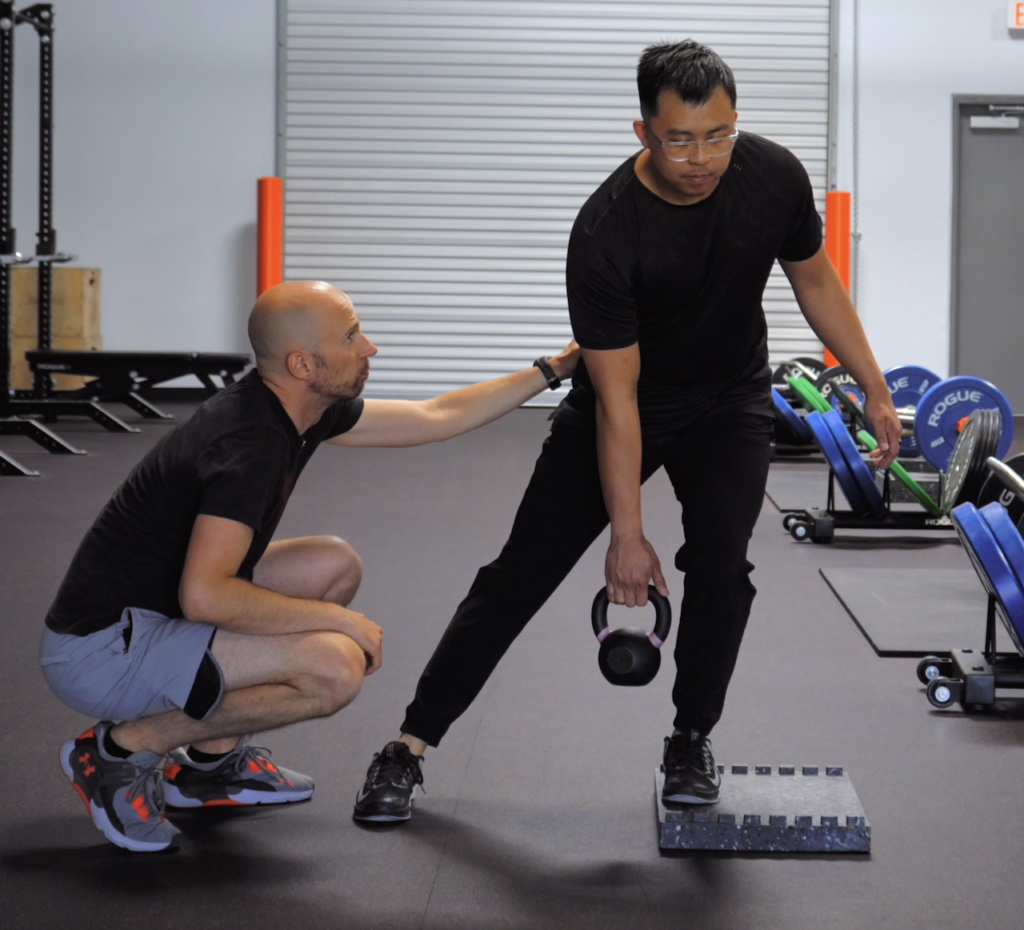
The goal with this move was to push right to left to initiate the turn left, and was a progression from the more static version we did last time.
I placed the weight in the right hand because his body would turn left to counterbalance the weight, then switch to the left to assist the turn back to the start position.
Kevin had a difficult time with this move. We had to really coach a few different pieces:
- Pushing from the right foot
- Keeping chest centered over left foot
- NOT bending through back
- oblique pelvis action
Eventually, he was able to hit most of these pieces, but I had to slow down the move and make it a lateral squat vs lunge.
After performing this move, Kevin’s test results were as follows (improvements are bolded; worse is italicized):
| Test | Left | Right |
| Shoulder flexion | 135 (+25) | 135 (+25) |
| Hip flexion | 110 (+10) | 100 |
| Straight leg raise | 80 | 80 |
| Knee extension | -5 | -7 |
| Ankle dorsiflexion | 15 | 20 (+10) |
| Ankle plantarflexion | 35 | 45 |
| Bilateral heel raise | Slightly less pain | |
| Unilateral heel raise | not tested |
Overall, some decent improvements, but not spectacular. I like the shoulder flexion changes and slight improvement in right dorsiflexion, but I was hoping for a lot more plantarflexion improvements.
It may have been the case that keeping the hips square wasn’t enough of a left turn to recapture left plantarflexion, so I opted to go with a different move for that.
Right rear foot elevated and heel elevated superhero split squat with ipsilateral load
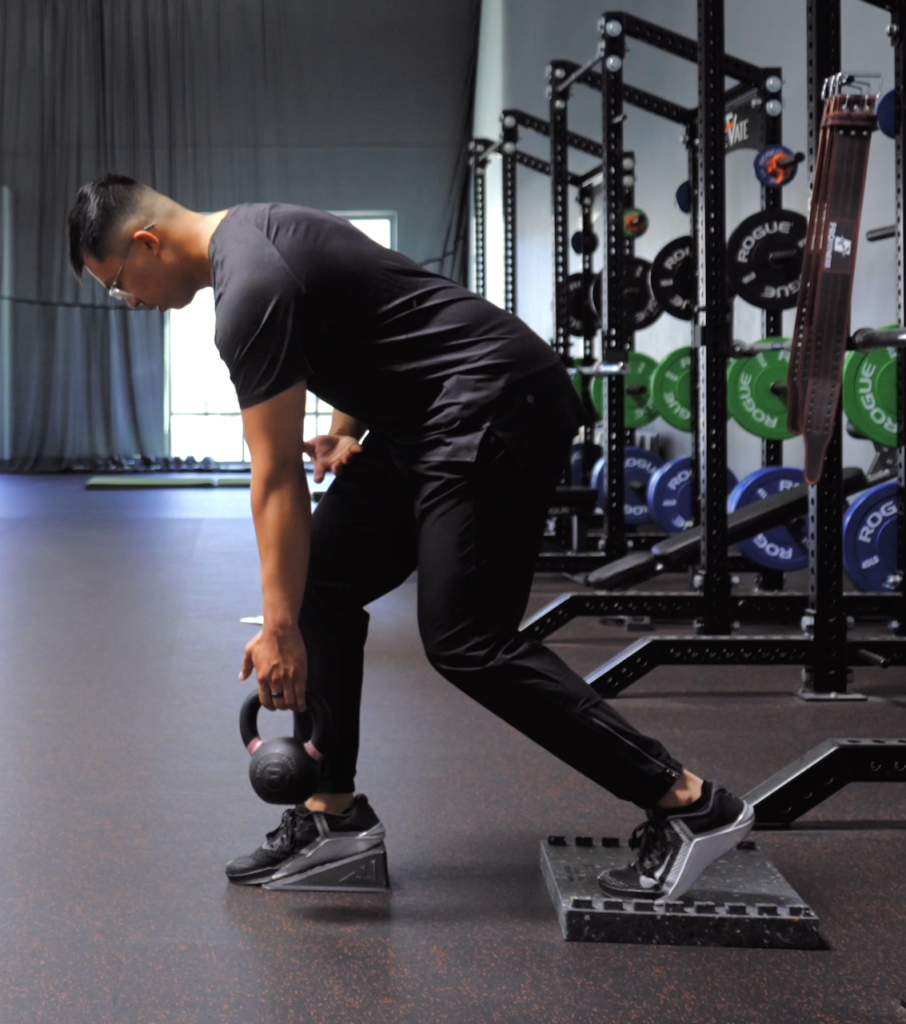
As you’ll see in the video, the finished product took A TON of trial and error to get something that felt good and made the desirable change.
So here were the big keys that helped us get some nice changes with this move:
- Right foot forward orients pelvis left
- The rear foot elevation increases loading on the front leg, which reduces the degree of left turn
- The heel elevation Increases external rotation on the front leg, which again minimizes the left turn
- The superhero/bent over position limits hip extension on the back leg and increases right posterolower expansion, which AGAIN limits the degree of left turn.
Why did I have to minimize the left turn to such a high degree? Because Kevin couldn’t turn left much in this position. How did I know that Check this picture below:
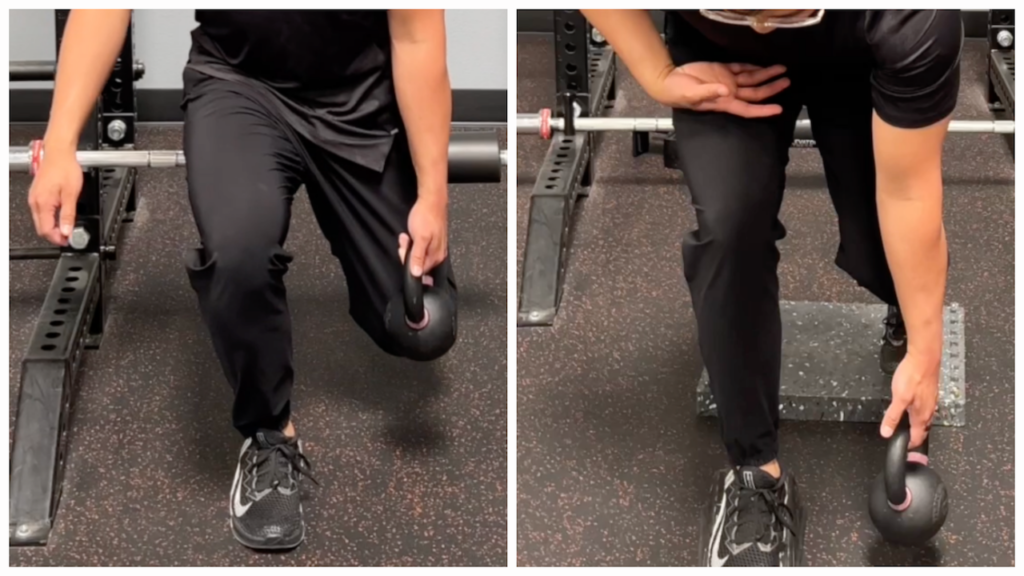
The picture on the left is from a plain old rear foot elevated split squat. Do you see how the back leg is abducted and the front leg is internally rotated compared to the final version? Why is this happening?
The reason why both legs are sweeping left is back Kevin cannot achieve the pelvis position desired (a left rotation), so he orients the entire pelvis and femurs to the left to achieve the position–a no go if you are trying to increase available motion.
Conversely, when I had him in the split squat variiation on the right, it was easier for him to attain the position because it wasn’t as far of a left turn, hence why his legs aren’t sweeping left as much.
With this move, here were the results we achieved:
| Test | Left | Right |
| Shoulder flexion | 135 | 135 |
| Hip flexion | 110 | 110 (+10) |
| Straight leg raise | 80 | 80 |
| Knee extension | -5 | -7 |
| Ankle dorsiflexion | 15 | 25 (+5) |
| Ankle plantarflexion | 40 (+5) | 45 |
| Bilateral heel raise | No pain | |
| Unilateral heel raise | painful |
Boom! A pain-free heel raise, with slight discomfort on a single leg version. You can also see we finally got ankle plantarflexion to budge, as well as a few other measures. Progress dear fam!
We still needed more plantar flexion, so I decided to use fewer constraints for my next move AND make it more plyometric-like to solidify the GAINZ.
Step down landing (left to right)
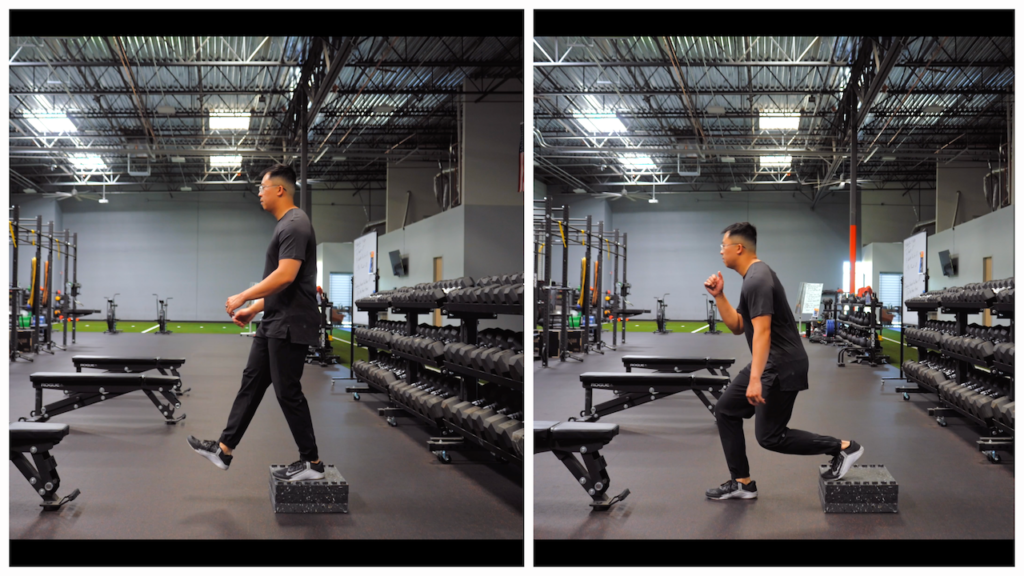
As you can see, this move still travels along the left oriented pelvis train, but we are driving left plantarflexion and creating some stiffness on the right leg during the landing phase–an action that will help create a left turn in the pelvis.
Because Kevin didn’t have full ankle plantarflexion, I had him hold onto left heel contact for as long as possible, which limited the plantarflexion range being expressed.
With this move, we got some pretty nice changes:
| Test | Left | Right |
| Shoulder flexion | 135 | 135 |
| Hip flexion | 110 | 110 |
| Straight leg raise | 80 | 80 |
| Knee extension | -5 | -7 |
| Ankle dorsiflexion | 15 | 25 |
| Ankle plantarflexion | 45 (+5) | 45 |
| Bilateral heel raise | No pain | |
| Unilateral heel raise | pain-free |
A pain-free heel raise and full ankle plantarflexion. VICTORY…IS…MINE.
Post-treatment debrief
Though I could’ve went either way with the first move, we overall got some AWESOME changes with Kevin. Ankle motion was markedly improved and he was pain-free.
I think I would’ve subbed out the first move and moved the first two exercises forward had I done the session over again. My third move would’ve been a retro bound going right to left, which would push Kevin back into a left turn.
But that said, it was progress. My ultimate goal for Kevin will be to be able to orient the pelvis left while dorsiflexing the ankle without collpasing. If we do that, we ought to be in bidness!
How do you improve ankle pain during a heel raise? Comment below and let the fam know!

